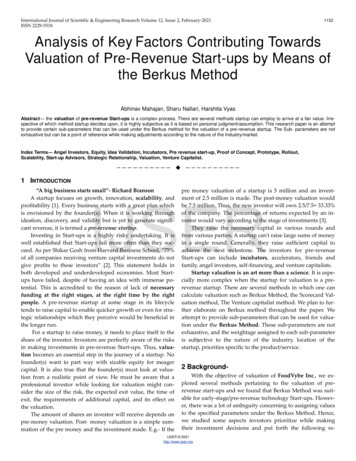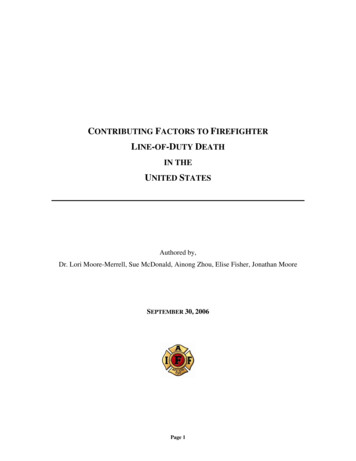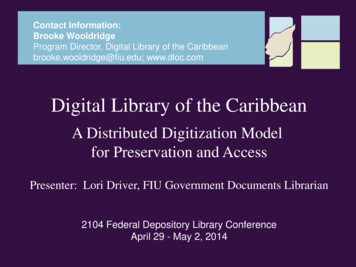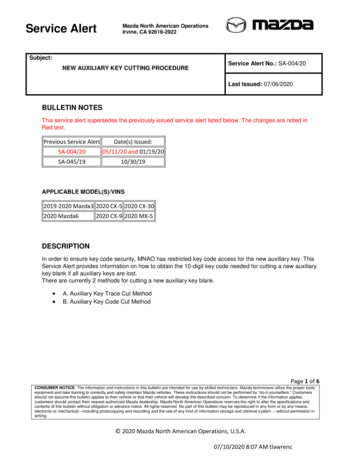
Transcription
International Journal of Scientific & Engineering Research Volume 12, Issue 2, February-2021ISSN 2229-55181132Analysis of Key Factors Contributing TowardsValuation of Pre-Revenue Start-ups by Means ofthe Berkus MethodAbhinav Mahajan, Sharu Nallari, Harshita VyasAbstract— the valuation of pre-revenue Start-ups is a complex process. There are several methods startup can employ to arrive at a fair value. Irrespective of which method startup decides upon, it is highly subjective as it is based on personal judgment/assumption. This research paper is an attemptto provide certain sub-parameters that can be used under the Berkus method for the valuation of a pre-revenue startup. The Sub- parameters are notexhaustive but can be a point of reference while making adjustments according to the nature of the Industry/market.Index Terms— Angel Investors, Equity, Idea Validation, Incubators, Pre revenue start-up, Proof of Concept, Prototype, Rollout,Scalability, Start-up Advisors, Strategic Relationship, Valuation, Venture Capitalist.—————————— ——————————1 INTRODUCTIONIJSER“A big business starts small”- Richard BransonA startup focuses on growth, innovation, scalability, andprofitability [1]. Every business starts with a great plan whichis envisioned by the founder(s). When it is working throughideation, discovery, and validity but is yet to generate significant revenue, it is termed a pre-revenue startup.Investing in Start-ups is a highly risky undertaking. It iswell established that Start-ups fail more often than they succeed. As per Shikar Gosh from Harvard Business School, “75%of all companies receiving venture capital investments do notgive profits to these investors” [2]. This statement holds inboth developed and underdeveloped economies. Most Startups have failed, despite of having an idea with immense potential. This is accredited to the reason of lack of necessaryfunding at the right stages, at the right time by the rightpeople. A pre-revenue startup at some stage in its lifecycletends to raise capital to enable quicker growth or even for strategic relationships which they perceive would be beneficial inthe longer run.For a startup to raise money, it needs to place itself in theshoes of the investor. Investors are perfectly aware of the risksin making investments in pre-revenue Start-ups. Thus, valuation becomes an essential step in the journey of a startup. Nofounder(s) want to part way with sizable equity for meagercapital. It is also true that the founder(s) must look at valuation from a realistic point of view. He must be aware that aprofessional investor while looking for valuation might consider the size of the risk, the expected exit value, the time ofexit, the requirements of additional capital, and its effect onthe valuation.The amount of shares an investor will receive depends onpre-money valuation. Post- money valuation is a simple summation of the pre money and the investment made. E.g.- If thepre money valuation of a startup is 5 million and an investment of 2.5 million is made. The post-money valuation wouldbe 7.5 million. Thus, the new investor will own 2.5/7.5 33.33%of the company. The percentage of returns expected by an investor would vary according to the stage of investments [3].They raise the necessary capital in various rounds andfrom various parties. A startup can't raise large sums of moneyin a single round. Generally, they raise sufficient capital toachieve the next milestone. The investors for pre-revenueStart-ups can include incubators, accelerators, friends andfamily, angel investors, self-financing, and venture capitalists.Startup valuation is an art more than a science. It is especially more complex when the startup for valuation is a prerevenue startup. There are several methods in which one cancalculate valuation such as Berkus Method, the Scorecard Valuation method, The Venture capitalist method. We plan to further elaborate on Berkus method throughout the paper. Weattempt to provide sub-parameters that can be used for valuation under the Berkus Method. These sub-parameters are notexhaustive, and the weightage assigned to each sub-parameteris subjective to the nature of the industry, location of thestartup, priorities specific to the product/service.2 BackgroundWith the objective of valuation of FoodVybe Inc., we explored several methods pertaining to the valuation of prerevenue start-ups and we found that Berkus Method was suitable for early-stage/pre-revenue technology Start-ups. However, there was a lot of ambiguity concerning to assigning valuesto the specified parameters under the Berkus Method. Hence,we studied some aspects investors prioritize while makingtheir investment decisions and put forth the following re-IJSER 2021http://www.ijser.org
International Journal of Scientific & Engineering Research Volume 12, Issue 2, February-2021ISSN 2229-55181133search paper.3 PROBLEM STATEMENTBerkus Method is a relatively simple and vague method, thusmaking the usage subjective. It lacks proper reference as tohow a founder while valuing his pre-revenue startup couldassign an appropriate/apt value to the parameters specified inthe method.4 OBJECTIVETo provide key sub parameters (or) a guide with respect tofurther pursuing valuation under the Berkus method and allocating an apt value for each parameter.Initially, each parameter was valued at 500,000. Berkus hadset the target for start-ups revenue at 20 Million (5th year),thus allowing investors a 10x return. After 20 years (2016), Mr.Dave Berkus updated the values to be at either 1 million (or) 2 million depending on the location/industry [6]. Valuationsare higher in Silicon Valley, Silicon Beach, New York, NorthCarolina, or such commercial renown locations. Mr. DaveBerkus aimed to provide flexibility to the users of this method.He quoted the following example justifying the raise of thevalue of each element - “In Silicon Valley, a “big data” startup might competitively call for a 1.5 million maximum value per element, while the same start-up in Nebraska mightfind 500,000 appropriate.” Thus, it is left to the discretion ofeach individual start-up to decide as to choosing the maximum amount to be allocated under each given parameter.7 KEY CRITERIA UNDER THE BERKUS METHOD5 METHODOLOGY-7.1 SOUND IDEA (PRODUCTION RISK, BASIC VALUE)IJSERWe performed basic qualitative research using secondarydata sources available which have been specified in the sectionof the bibliography. This paper includes the views presentedby reputed authors in the field of finance along with studiesconducted by various Universities.6 THE BERKUS METHODThe method is named after an angel and venture capitalistDave Berkus [4]. He specialises in early-stage investing intechnology start-ups. He was an early pioneer in the minicomputer industry, guiding the company he founded, Computerized Lodging Systems, Inc. This method emerged in themid-1990s for valuation of early-stage companies and waslater revised [5]. This method accounts for some of the mainrisk factors and attempts to give an admittedly arbitrary valueto each of the factors highlighted below.Table1Quantitative Value Drivers [5]ParticularsValuesSound Idea (Basic Value) 1 million (or) 2 millionPrototype (Reduces Technology Risk)Quality Management Team(Reduces Execution Risk)Strategic Relationship (Reducing Market Risk)Product Rollout/Initial Sales.(Reducing Production Risk) 1 million (or) 2 million 1 million (or) 2 million 1 million (or) 2 million 1 million (or) 2 millionAn idea can be defined as a thought or a course of action.Every start-up begins with a great idea. A start-up in essence isan idea that is derived from the founder. A good idea is onethat has the potential to solve an unsolved problem or improve the existing business model of the target industry. Studies indicate that only one idea out of 3000 is successful. Irrespective of the quality of an idea, it has to be refined over thecourse of time. This practice is known as pivoting [7].One mistake that is widely observed is when a startupincurs massive expenditure before even validating the idea. Agood idea must be backed by evidence that customers problem is being solved. Idea validation is a key factor in terms ofthe valuation of the business.‘Building before validating’ must be avoided. This step involves the entrepreneur through methods of survey and research enquiring to check if the problem he wants to solveexists in the market. The price fixation can also be done duringthe stage of validation by gauging the price the target customers are willing to pay. A founder must keep an open mind during the stage of validation and be flexible to pivot if necessary.A business idea is one that checks all the factors belowNumber of potential customers*Percentage of thecapturable market*Absolute dollar amount of eachsale*Percentage margin of Net profit Total Potential Profit [3]A start-up idea fails when the idea is to solve an irrelevantproblem, is not properly executed, and faces an external threat[8].Business idea planning is a continuous process. In postidea validation stage, the start-up must conduct a final evaluation with a larger target audience.Sub-Parameter -IJSER 2021http://www.ijser.org
International Journal of Scientific & Engineering Research Volume 12, Issue 2, February-2021ISSN 2229-55181.2.3.4.5.Proprietary nature of the idea - A novel idea musthave the potential to be secured via patents/ copyrights along with possessing the scope to generatesignificant returns.A well-defined future plan [9] - investors alwayslook at the big picture when investing, hence a startup promising longevity in a well-planned directionbecomes essential.The scalability of idea [10] - a scalable business canexpand with a minimal incremental cost. Thus, astart-up in order to survive in a competitive marketmust have a scalable idea.Socio-political relevance - the appeal of the start-upidea to the general audience is heavily reliant on theprevailing socio- political climate, thus the idea beingrelevant is necessary.Validation of idea - in order to minimize the risk during the stage of implementation the idea must be subjected to thorough testing with a large audience.1.2.3.4.5.Completion status of the prototype– A completedprototype consisting of most of the features the product plans to roll out is a good sign for the investors.Proof of concept/ user feedback to back the effectiveness of the application/site -Involving users inthe early process assists in getting genuine views anda better understanding of the product. It helps toprove there are people eager to use the applicationwhich makes it easier to attract funding from VCsthus draws positive valuation.The possibility to license the product/prototype inthe early stage – The product having the capability tobe licensed in the early stage, provides a safety net/exit for investors.User Interface/ ability to withstand large volumewithout failure/technical glitches – A user-friendlyinterface that can handle a large volume of customerswill help the start-up in developing the final product.The presence of well-experienced personnel in thefield of technology - start-ups having high-leveltechnical experts will attract a positive valuation asthey will be in a better position to identify the technical problems associated and resolve the same. Aclear documentation and coding process is required.IJSER7.2 PROTOTYPE (REDUCING TECHNOLOGY RISK)Prototype is the key parameter under valuation of startups by the Berkus method [11]. It is a replica of the actual concept or product in order to test its viability. The main notion ofprototyping is to confront the identified loopholes or defectsbefore the bulk investment of energy, money, and time.Start-ups looking for funding from venture capitalists or angelinvestors must not underestimate the importance of the prototype, as it proves the products’ functionality [12].A prototypeshows the seriousness, dedication, knowledge, and vision ofthe founder(s). Involving feedback in the prototype is important as it gives the founder(s) scope to further dwell uponnew ideas. Thus, presenting, and testing of product at an earlystage, getting feedback and making the required changes provide an upper hand and increases the confidence of the potential investors.Prototyping acts as a technological risk management technique for start-ups [13].There are various technology risks associated with IT products like breaching of confidential data,system/service breakdowns, cyber-attacks, and many morewhich have a bearing on the reputation business.A product and its functioning are the foundation for any valuation. A product is expected to be unique, create an impact,solve an existing problem/ cater to an untapped market, seekto outperform the existing firms/peers, etc. Any product thathas fulfilled most of the above-mentioned goals is ideal. Thisfurther emphasis doing the groundwork to arrive at a feasibleprototype.Sub-Parameters [14] -11347.3 MANAGEMENT VALUATIONFor any business to attain success, the business founder(s)play an important role [3]. A venture capitalist or angel investor would first examine the domain experience/track record ofthe founder(s). If the business founder has achieved success/reputation in the domain concerning the start-up, itwould be of higher weightage in terms of valuation of themanagement. This provides a sense of security regarding theefficiency of the management [15]. The running of a team boilsdown to two words- Good management. Higher the capability of the management, higher the valuation. Incase, if thefounder(s) skillset is limited, assembling a team/ enthusiasticpartners becomes vital.A strong start-up team gives the opportunity to achievehigher innovation, drive business growth, ensure quicker conversion from ideation to the production stage, survive in a cutthroat environment, cover all aspects/bases that are meant tobe covered in a start-up, and also command a higher valuation/funding.As per Eva de Mol, 60% of start-ups fail due to problemswith the team [16].For valuing a start-up's management- theventure capitalist relies heavily upon his gut feel/intuition.A recent study was conducted by Harvard Institute on 95start-ups in Netherland. From this study, we deduce that experience solely was not sufficient. “Entrepreneurial Passion”and “Shared Vision” are two main factors that determines aIJSER 2021http://www.ijser.org
International Journal of Scientific & Engineering Research Volume 12, Issue 2, February-2021ISSN 2229-5518successful team. A team of highly experienced founders having several years of relevant domain related experience but arenot extremely passionate about the business, their chances ofsuccess diminish. Conversely, a team lacking domain experience but have the passion and common vision, tend to have ahigher chance of working/functioning the start-up efficiently[16].The team can have advisors who may help them throughthe process of start-up development [3]. The advisors maywork on a consultancy basis for a fee or partner with the startup out of his benevolence or interest without charging a fee(desire to pay it forward in the form of sharing what they'velearned over the years). Mentors are crucial but not compulsory. It is however beneficial to have an advisor with an established network in the specific domain of the start-up. An advisor with solid industry specific knowledge could be vital inproviding a sense of assurance to an investor. A founder(s)may tend to develop a deep sense of attachment towardshis/her idea over the years, thus the presence of an advisorwould provide him the ground reality.Sub parameters/criteria1. The technical or commercial competency of the foundingteam. This can either mean the founders have the relevantprior experience of incubating a start-up or they havedeveloped the appropriate skills necessary to executethe goals set before them. A team needing additionalsupervision in the form of a higher- level management team.2. The management’s awareness of their limitations andappointing specific people to overcome such shortcomings E.g. - The firm has identified that management doesnot have a member with legal acumen and hence hashired an external third-party legal team to be part ofthe start-up incorporation/ filing patents.3. The share/equity/stake among the founding members. A start-up in which a founding member has a largestake ensures that he/she will remain motivated. Ifthere are many founders, the equity spread amongthem being equal is an advantage.4. Founder Flexibility. i.e., the founder’s willingness to pivot/ allow an external monitory body to take the control ofthe management. The founder may not be an expert in management orfunctioning of the business if, in the best interest ofthe firm, the founder's willing to implement additional higher management.1135all potential investors that the management is wellcontrolled in all aspects by the founders.7.4 STRATEGIC RELATIONSHIPS (REDUCING MARKETRISK)“Business is all about relationships, how well you buildthem determines how well they build your business”- BradSugarsStrategic relationships are the collaborations between twoor more parties in order to achieve mutual benefits [17]. AStart-up usually enters into strategic relations with parties thatare huge and well established in order to exploit their expertise and resources. It is often seen that chains of production/distribution are incomplete in start-up's and they leveragethese relationships to ensure smoother rollout/functioning.Start-ups success rate is rather low and a firm possessingsuch relationships is bound to benefit in terms of success andvaluation. The type of strategic relationship will vary as perthe need and nature of start-up but this would assist them inincreasing the customer/user base, exhilarating promotionalactivities, added value and trust of people. Thus, turning theodds in favour of the start-up [18].The Pre-revenue start-ups or any other organization irrespective of the size or nature cannot neglect the market inwhich they exist. The market which surrounds the industry isdynamic and challenging thus a thorough understanding andresearch of it is a crucial step. Strategic relations are decisionsthat need to be taken with enormous care. They are in essencethe building blocks of a start-up [19].An example of the strategic relationship between twocompanies would be Spotify and Uber. Uber riders have theoption to control the music of each ride with Spotify, thusmaking the experience of the ride satisfactory and Spotifyservices will be used by the riders, thus enabling brandingand advertisement [20].Note- The above example is stated for two well-establishedfirms, the same is true for the start-up.In order to value Strategic relationship which is one of the keyparameters under the Berkus method, the following subparameters can be taken into consideration.Sub-Parameter 1. Existing Rivalry-IJSER5.Diversity of skills among the founders The founders, if many, have experience in a widerange of skill sets it would be a further assurance toA start-up facing rivalry in the industry will struggle to leverage valuable strategic relationships. Thus, the market in whichthe start-up is present plays an important role in commandingvaluation.2. Effect of strategic relationship on the efficiency of thestart-upA start-up needs to justify qualitatively/ quantitatively as toIJSER 2021http://www.ijser.org
International Journal of Scientific & Engineering Research Volume 12, Issue 2, February-2021ISSN 2229-5518how a particular the strategic relationship will help their future prospects.3. The strategic relationship may bring new business/add to existing satisfaction of the customersBy entering into a strategic relationship, the start-up is able toexpand the customer base or bring new customers.4. The capability of the strategic relationship in preventing a competitive threat [21].Firms/ Start-up enter into relationships in order to be wellequipped to have resources to compete with threats/ competitors which are likely to arise during the business.5. The strategic relationship had covered considerablean amount of risk which the start-up was prone to.If the start-up identifies a risk, it will make efforts to enter intoagreements/partnerships for the purpose of risk mitigation.7.5PRODUCT ROLLOUT/SALES (REDUCING PRODUCTIONRISK)3.4.5.1136The customer support team has been properly trainedon the product and is ready to assist new users withtheir common questions, issues, and problems.Preparation and implementation of order handlingplan- the start-up must be capable of handling the estimated orders it projects along with having a plan tomeet excess demand that may arise.The firm has set clear goals and developed a go-tomarket plan for the product/service.On completion of the goals of product rollout, the firmcan draw a fair conclusion if the start-up is moving towardsthe intended ultimate goal and make the necessary changes, ifso required. Thus, a systematic rollout with defined objectivesdraws positive valuation.8 CONCLUSIONEarly-stage start-up valuation is an art rather than a science.As the start-ups projected results can significantly vary fromthe ground results. A start-up founder ought to evaluate thepros and cons before finalising a method of the valuationwhich he deems to be apt for his business. The Berkus Methodis widely used for valuation of technology start-ups. Themethod uses the 5 factors which are thought to be the driversof a start-up in terms of valuation. The assignment of values tothe drivers of value is left at the discretion of the founder. Thestart-up ought to choose the hurdle number/target that isachievable in a span of 5 years. It is only upon determination/projection of revenue, the founder can proceed with determining the maximum value which could be assigned toeach parameter. A detailed preparation of a financial modelcould be useful in helping the start-up determine/project thegrowth. The claim of this method being oversimplified cannotbe ignored. The major limitation is the subjectivity of themethod. But if the founder utilises and develops clear justification for the chosen assigned value using certain key subparameters (depending upon the nature of the business/industry), the Berkus Method can be a viable method forvaluation of a pre revenue start-up.IJSERProduct rollout is an imperative factor that determinesthe success or failure of any start-up. Product Rollout is thelast and the most crucial stage of the product developmentprocess. The product rollout can transpire in a limited orglobal market, varying upon the target market size in which itwill be rolled out initially [22].It is an interior analysis of thestart-up’s ability to market and sell its product. The process ofrollout starts from pre-launch and also includes the stages oflaunch of the product and managing the activities postlaunch.8The founder(s) must plan the rollout diligently as it hasthe potential to diminish the threat, enable efficient and effective use of resources, setting the deadline, and ultimatelymeasures the success of the product post launch. The rolloutteam should develop a product protocol, a highly aggressivemarketing strategy advertising the benefits the target audience can derive and keep a check on whether the start-up ismoving in the intended direction. The success of a rollout is agreen signal for the future expansion plans of the start-up witha clearer vision and knowledge to proceed further.Sub-Parameters [14]:1. The product has been tested, run through QA, andproven capable of holding up to the expected standard. - The product rollout attracts a positive valuationwhen the product has been tested and any negativefinding in this process of the initial rollout has beenaddressed.2. The start-up must have evidence that the customer iswilling to pay the target price. The price point mustbe well tested.9 Glossary Valuation- Process of assessing the worth of a company/start-up in financial terms. Pre revenue startup- A startup which is yet to generate sale of its product/services. Incubators- Provide assistance to Start-ups via training, mentoring and connections with investors.IJSER 2021http://www.ijser.org
International Journal of Scientific & Engineering Research Volume 12, Issue 2, February-2021ISSN 2229-5518 Angel investors-A high Net Worth individual whoprovides funding at an early stage to startup. He is also known as key investors. Venture Capitalists-A private equity investor providing growth capital to early-stage Start-ups. Idea validation- Process of testing, gathering evidence around ideas through experimentation/studiesbefore launching the product/service to the target audiences.6.7.8. Scalability- The ability to expand and can be adaptedto a bigger scale/level.9. Prototype- An early sample, model of a product totest the concept/process. Proof of Concept- Also known as proof of principle. Itrefers to a feasibility check. Startup Advisors- An individual who provides thestartup with connections and guidance.11. Equity/Stake- Percentage of ownership.12. Strategic Relationships- Partnerships formed tocounter an external threat (or) improve own efficiency. Rollout- Product release or introduction of a serviceto the -the-berkus-method-ofvaluation/#: :text %20the%20idea%20itself . 16Nov.2016.Dave Berkus, “The Berkus Method – Valuing The Early Stage Investment,” Retrieved fromhttps://berkonomics.com/?p 131 . 4 Nov.2009.H.Beverly, “ Navigating Your Way To Startup Success,”Walter de Gruyter GmbH & Co KG, 2017J.Pride, “Unicorn Tears: Why Start-Ups Fail And HowTo Avoid It,” John Wiley & Sons,pp.51-61,2018Mc Cord et al, “Product Rollout: A Toolkit for Expanding a Tested Product throughout the les/pdf/1365400455 Product Rollout Overview.pdf . pp. 12-17,2004L.Tvede, & M. Faurholt,“Entrepreneur: Building YourBusiness from Start to Success,” John Wiley &Sons.pp.112-113,2018.Ramírez, V. (2018, September 5). What is a prototype?Retrieved from 24ff9400cfdAleksandra, “How To Make A Prototype That WillGet Investors To Fund Your Startup?,” Retrievedfrom otype-that-will-fund-your-startup/,4 Dec.2019.“What Is Technology Risk?”, Retrieved echnology-risk/ .2020Kirsch, “Product Launch Checklists — they’re MoreImportant Than You Think,” Retrieved klist/ . 29 Jan. 2021.A.Cremades, “The Art Of Startup Fundraising: Pitching Investors, Negotiating The Deal, And EverythingElse Entrepreneurs Need To Know”. John Wiley &Sons.pp.40-45.2016Mol, “What Makes a Successful Startup Team,” Retrieved from rtup-team .21 Mar.2019.Picincu, “What Is The Meaning Of A Strategic Partner?,” Retrieved from ic-partner-.html . 26 Oct.2018Business.com editorial staff, “5 Benefits of StrategicPartnerships,” Retrieved eystrategic-partnerships/ . 19 Oct.2016IJSER13.Steve blank, “Make No Little Plans – Defining thescalable startup,” Retrieved leplans-%E2%80%93-defining-the-scalable-startup/ .2010, January 25.D.Gage,” The venture capital secret: 3 out of 4 StartUPS fail,” Retrieved 43720204578004980476429190 . 2012, September 20.D.S.Rose, “The Startup Checklist: 25 Steps to a Scalable, High-Growth Business,” John Wiley & Sons,pp.215, 35-37, 2016.Dave Berkus, About Dave - Berkus.com. Retrievedfrom https://www.berkus.com/?page id 54Dave Berkus, “After 20 years: Updating the Berkusmethod of valuation,” Retrieved from15.16.17.18.IJSER 2021http://www.ijser.org1137
International Journal of Scientific & Engineering Research Volume 12, Issue 2, February-2021ISSN 2229-551819. P.N.Hague, N.Hague, & C.Morgan, “Market Researchin Practice: A Guide to the Basics,” Kogan Page Publishers.pp. 3-6.200420. Kamau, “Successful Strategic Alliances: 5 Examples ofCompanies Doing It Right,” Retrieved ing-it-right/ .6 Apr.2020.21. Wakeam, “The five factors of a strategic alliance,” Retrieved e-fivefactors-of-a-strategic-alliance/ . May 2003.22. Kentor, “ Rollout,” Retrieved sp#: :text C%20to%20generate%20consumer%20interest .2020IJSERIJSER 2021http://www.ijser.org1138
pre-money valuation. Post- money valuation is a simple sum-mation of the pre money and the investment made. E.g.- If the pre money valuation of a startup is 5 million and an invest-ment of 2.5 million is made. The post-money valuation would be 7.5 million. Thus, the new investor will own 2.5/7.5 33.33% of the company.











